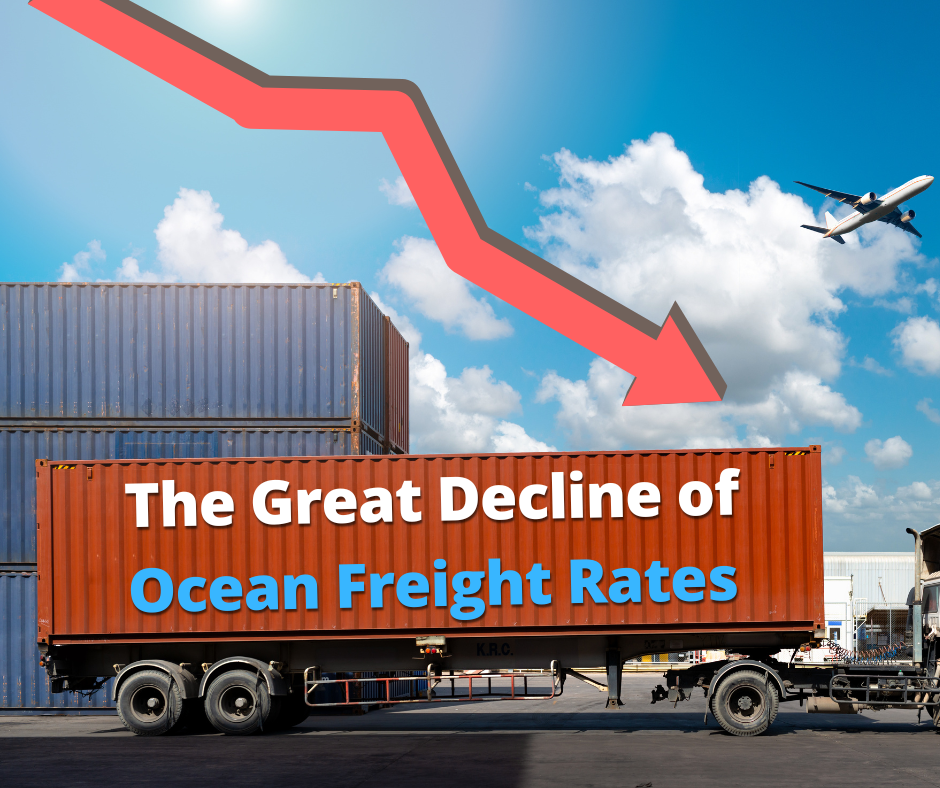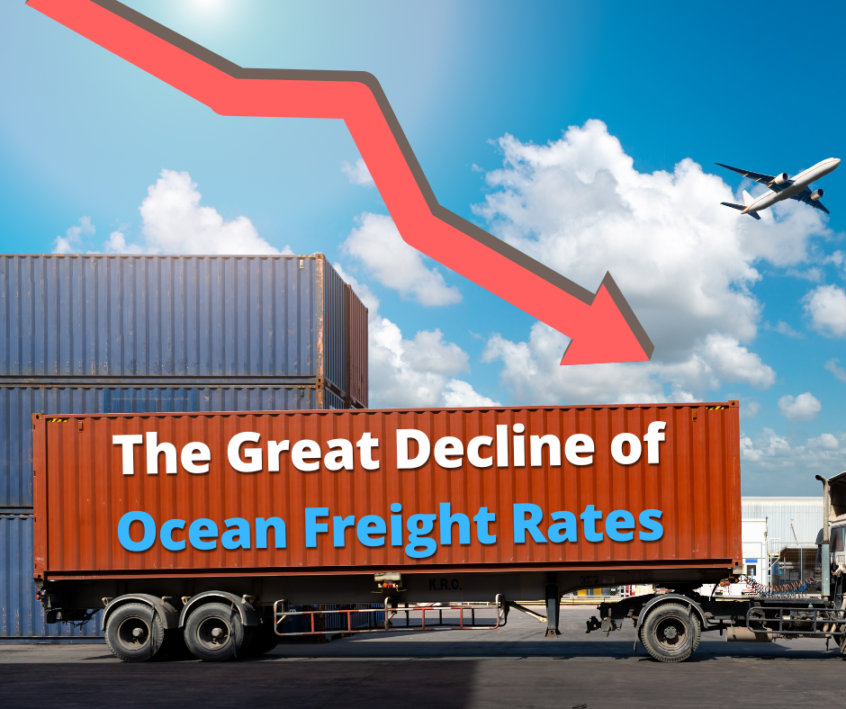
The implications for the shipping industry today
The news coming from the industry indicates that the predicted fall in container demand has occurred. However, the unexpected aspect is that the fall is less orderly and steeper than anticipated levels. Shipping liner executives had expected these upheavals, but their arrival has taken on surprising patterns based on the latest quarterly calls. At the time, the executives had predicted a gradual drop and a smoothening of some of the worst effects. However, their predictions have not been entirely accurate.
Not to put too fine a point on this, but Patrick Jany of Maersk anticipated a progressive erosion instead of a single-day collapse. Meanwhile, Matt Cox of Matson predicted a slow adjustment and an orderly market that would not fall off a cliff. These predictions were optimistic at best. However, the spot rates are declining rapidly. Ben Nolan of Stifel reported the outcomes of recent executive meetings, which expressed surprise.
A shipping industry trying to make the right adjustments at the right time
The boom in demand at the time inspired Matson to introduce its third trans-Pacific service in June 2021, known as the China-California Express (CCX). A recent conference call with industry executives suggested that CCX would run through October, but that did not materialize. Softening demand meant that the last sailing of CCX took place before the targeted October 2022 conclusion date. This is a reflection of the fact that the steepest decline has been experienced in the Asia-West Coast market.
Frode Mørkedal of Clarksons Securities classifies the situation as plummeting spot rates, particularly regarding the Shanghai-U.S. West Coast corridor. A case in point is how the Freightos Baltic Daily Index (FBX) China-West Coast assessment has downgraded by 76% over the last six months. Currently, the estimates are $3,799 per forty-foot equivalent. Similarly, the Drewry Shanghai-Los Angeles trade assessment has been downgraded by 57% over the same period.
These reductions are not just monthly but can be as urgent as weekly downward adjustments. For example, the Drewry rate for Shanghai-LA fell another 11% in the last week. This was in addition to the previous week, which fell by 14%. Experts worry that there is limited clarity about where and when the market rates will reach their bottom during this slump.
Assessment of sailings soon
Whereas these downgrades in spot rates are taking place, there are important trends in sailings, which they might explain. For example, some experts predict more blank sailings after the so-called Golden Week. However, the origins of the current trends may be linked to the Covid-19 pandemic and some of the policy interventions designed to deal with that crisis. For example, the initial lockdowns implemented in North America and much of Europe meant that import demand fell significantly. The statistics for the 2nd quarter of 2020 attest to this reality.
In response, Ocean carriers triggered several blank sailings to a sufficiently robust level to bring capacity down. This would align it better with demand following cancellations so that the effects of over-capacity did not overburden the industry players. In this way, carriers were able to successfully control the spot-rate slide. The seemingly successful strategy has been cited as evidence that carriers can use blank sailings if demand becomes too low, reducing the rate or extent of price falls. That is why some expect a similar course of action to be triggered in the current circumstances.
Will there be a turning point for the rates to decline?
China’s Gold Week holiday, which runs from the 1st to the 7th of October, has been referenced as a key turning point in the latest trends. For example, there may be a program of blank sailings after that week. This would allow for tonnage to be reshuffled according to need. Most will be focused on balancing capacity and the dynamic marketplace. Nevertheless, the more pessimistic experts argue that spot rates are not yet near what they were in the past.
For example, during the 2nd quarter of 2020, the Drewry Global Composite Index fell to a low of $1,446 per FEU in late April. However, blank sailings prevented an even greater fall during the lockdowns. Before Covid-19, between 2018 and 2019, Drewry’s global index averaged $1,474 per FEU in. At the time, many carriers lost money. Last Thursday, Drewry’s global index was at $4,942 per FEU. This is 3.4 times higher than the pre-Covid 19 average and the lockdown low.
The impact of the Covid-19 pandemic on the shipping industry
Such a comparison of the Drewry Global Composite Index holds water even after a 44% decline experienced over the last six months, which amounted to an average loss of $650 per FEU per month. Analysts suggest that if the decline were to maintain this pace, the index would still not reach the pre-Covid 19 levels until the middle of the first quarter of 2023. Indeed, if the same pace of decline were maintained for the next three months, the Drewry Global Composite Index would still be double what it was in the pre-Covid 19 era.
It is important to acknowledge that contract rates are a key factor in supporting carriers’ profitability. That means that a decline in spot rates does not have the same effect on ocean carriers as in the pre-pandemic period. This is because of the significant changes that have taken place in the contract market. For example, carriers now have more of their volume on annual contracts rather than depending on the tender mercies of the spot rate market. A case in point I show Maersk had only 46% of its long-haul business on long-term contracting. Currently, the situation is reversed, with up to 71% of contracts secured for one or even more years.
Contract rates are now higher
The premium on predictability means that contract rates are now much higher than they once were. A portion of this year’s contracts will likely be renegotiated, while others will not be honored at all. Then, some contracts will allow carriers to offset the declines in the spot rates. Zim (NYSE: ZIM), an ocean carrier, indicated that contract rates for 2022 are double what they were the previous year. Some hikes of more than 50% were reported in 2021 as well compared to 2020.
These trends are exemplified by the direction of the likes of Xeneta. This is an organization that publishes an index tracking long-term freight rates. By August, the Xeneta index had reached 453 points. This is 4.5 times what it was in the pre-Covid 19 era. A year-on-year comparison shows that the index has risen by 121% this year.
Wrapping up
There had been an expectation that as demand reduced, the spot rates in the shipping industry would decline. However, that decline was expected to be gradual and orderly. Instead, the recent statistics indicate a very steep decline in a rather abrupt and disorderly manner. Given that unexpected trend, some shipping companies are gradually shifting into long-term contracts. The overall impression is a shipping industry that must remain on its toes in the post-Covid 19 seasons.



One Comment on ““The Great Decline of Ocean Freight Rates Signaling a Big Drop in Consumer Demand””
this is a great article aboutOcean freight rates
thank you